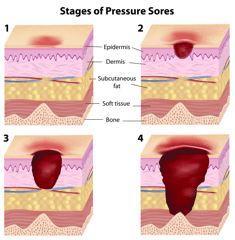When a person decides to become a home care giver (whether professionally or personally), he or she will have a lot to learn. There are many complications to taking care of someone who is unable to manage basic functions and it's important to be prepared for everything. When people are bedridden, one of the more unpleasant and unforeseen consequences of their condition is bedsores.
Bedsores (or pressure sores, as they are sometimes called) are wounds to the skin that often occur in parts of the body that experience the greatest pressure from bones. When a person is unable to change positions for long periods of time, the pressure from the weight and bones reduces blood flow to the area and damages the skin, causing it to stress and rupture into round holes. There are four stages of this condition and, when advanced enough, it can penetrate deep enough to expose muscle and bone.
There are several ways of preventing bedsores in the first place, the most important and successful of which is to encourage those with limited mobility to change positions every so often and to turn people who can't move. This should be done every couple of hours at the very least, but more often when convenient.
However, if a sore forms anyway, there are several things that can be done to treat it:
- Dead tissue should be removed- The way to do this should be determined by the severity of the case. If at stage 2, for instance, an autolytic dressing (which enhances the body's natural ability to break down dead tissue) might be enough to do the job. If at stage 4, surgical removal may be necessary. Consult a doctor for the best course of action.
- Pressure Relief- Stop the problem at its source and aid recovery by turning the person more often and providing better cushioned surfaces.
- Cleaning- When a sore is still closed, simple soap and water can be used to clean it, but it becomes necessary to use antiseptic saline when the wound has opened.
- Dressing- There are many dressings that can be used for sores and all of them prevent bacteria from entering the wound site. If the sore is not infected and is relatively shallow, a dressing like Duoderm can be used. This particular dressing will actually absorb the fluid that comes from the site and keep it damp and free of bacteria. The bandage is self-adhesive (even in a wet area), but does not stick to the wound and can be cut to suit any size or shape necessary. If the bedsore seems to be producing a large amount of discharge, Duoderm can be changed more often, as needed.
- Medication- Patients who are experiencing pain from sores or who have an infection may need medication, as well.
When taking care of patients at home or family members, it's important to know what to do oneself and when to get help. People who are unsure of a treatment or who think that their patient might need medication should consult a doctor for the best course of action to take.
Browse our collection of wound care supplies for the best products.
Sources
Recognizing and Treating Pressure Sores


